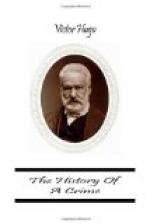Shorthand reproduces everything except life. Stenography is an ear. It hears and sees not. It is therefore necessary to fill in here the inevitable blanks of the shorthand account.
In order to obtain a complete idea of this sitting of the Tenth Arrondissement, we must picture the great Hall of the Mairie, a sort of parallelogram, lighted on the right by four or five windows overlooking the courtyard; on the left, along the wall, furnished with several rows of benches which had been hastily brought thither, on which were piled up the three hundred Representatives, assembled together by chance. No one was sitting down, those in front were standing, those behind were mounted on the benches. Here and there were a few small tables. In the centre people walked to and fro. At the bottom, at the end opposite the door, was a long table furnished with benches, which occupied the whole width of the wall, behind which sat the “bureau.” “Sitting” is merely the conventional term. The “bureau” did not “sit;” like the rest of the Assembly it was on its feet. The secretaries, M.M. Chapot, Moulin, and Grimault wrote standing. At certain moments the two Vice-Presidents mounted on the benches so as to be better seen from all points of the room. The table was covered by an old green tablecloth, stained with ink, three or four inkstands had been brought in, and a quire of paper was scattered about. There the decrees were written as soon as they were drawn up. They multiplied the copies, some Representatives became secretaries on the spur of the moment, and helped the official secretaries.
This great hall was on a level with the landing. It was situated, as we have said, on the first floor; it was reached by a very narrow staircase.
We must recollect that nearly the whole of the members present were members of the Right.
The first moment was a serious one. Berryer came out to advantage. Berryer, like all those extemporizers without style, will only be remembered as a name, and a much disputed name, Berryer having been rather a special pleader than an orator who believed what he said. On that day Berryer was to the point, logical and earnest. They began by this cry, “What shall we do?” “Draw up a declaration,” said M. de Falloux. “A protest,” said M. de Flavigny. “A decree,” said Berryer.
In truth a declaration was empty air, a protest was noise, a decree was action. They cried out, “What decree?” “Deposition,” said Berryer. Deposition was the extreme limit of the energy of the Right. Beyond deposition, there was outlawry; deposition was practicable for the Right, outlawry was only possible for the Left. In fact it was the Left who outlawed Louis Bonaparte. They did it at their first meeting in the Rue Blanche. We shall see this later on. At deposition, Legality came to an end; at outlawry, the Revolution began. The recurrence of Revolutions are the logical consequences of coups d’etat. The deposition having




